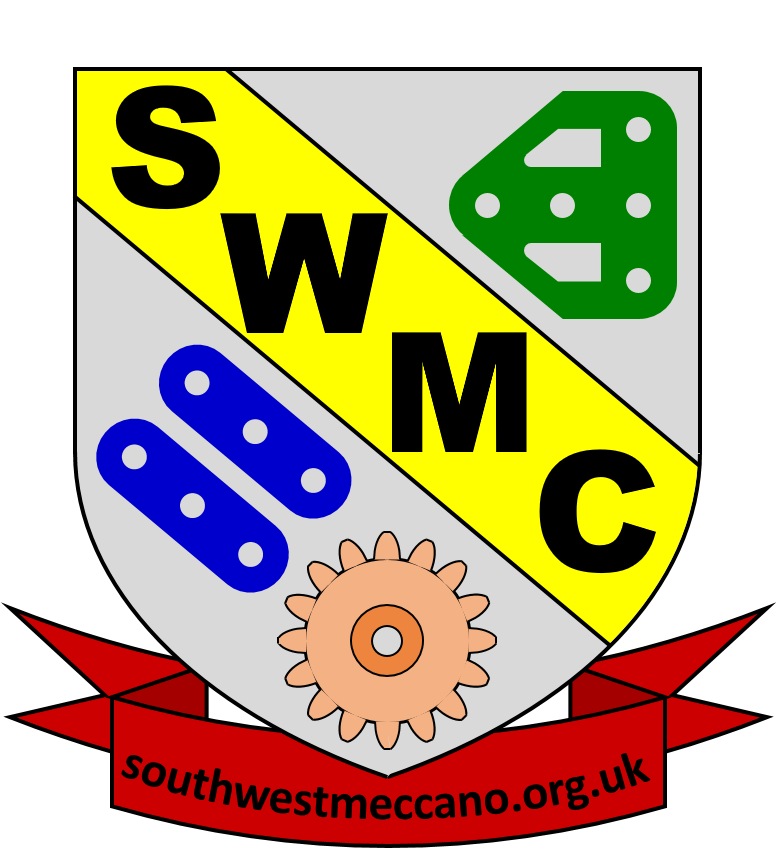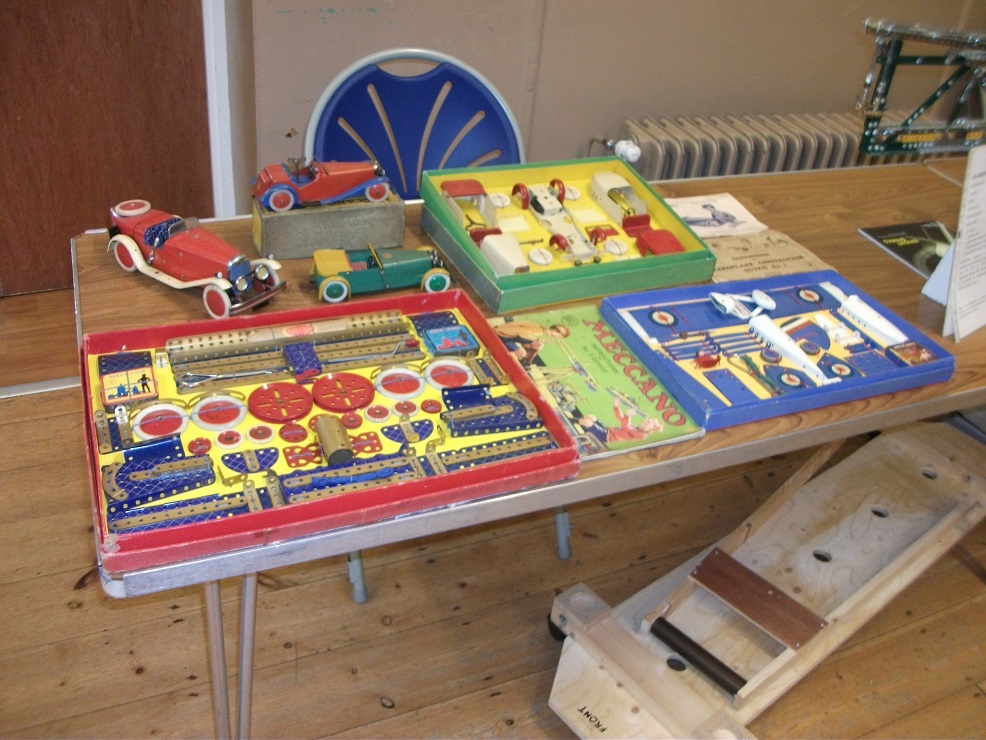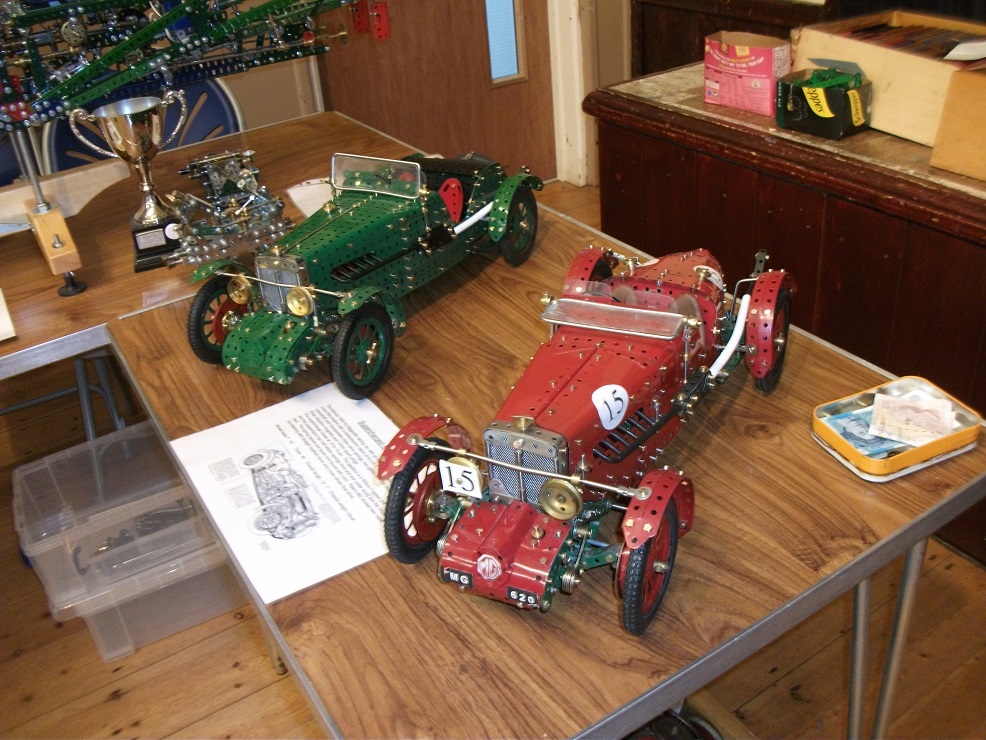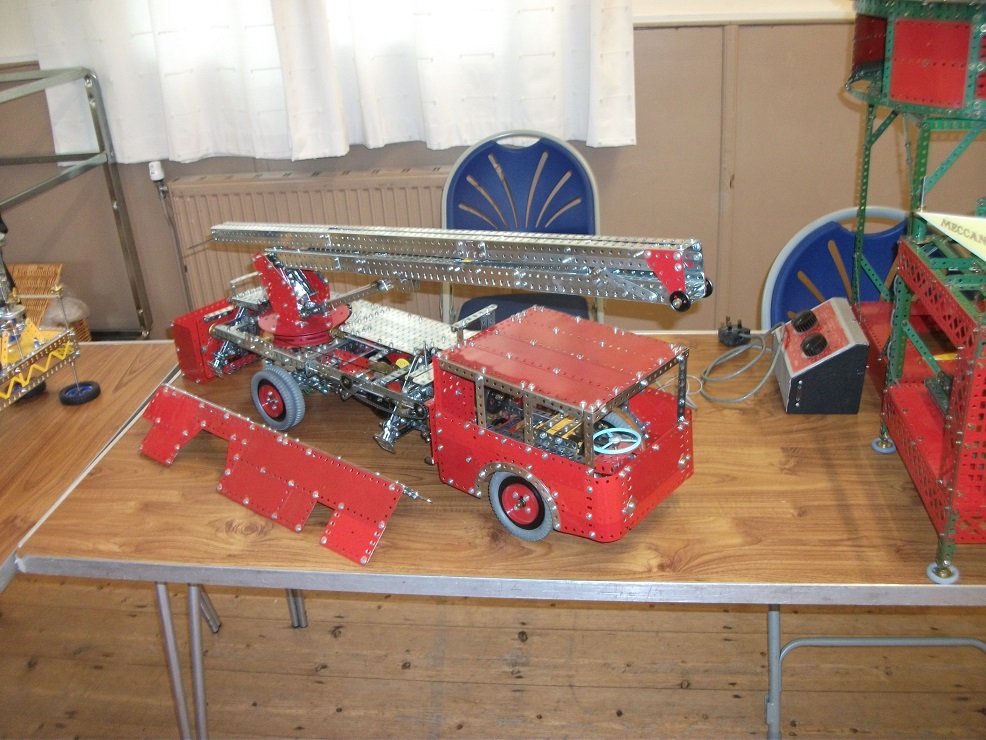April 2017 Exhibition Model Report
Whilst numbers were down a little this year (in terms of both club members and visitors) we all enjoyed another great day. We were able to sell (or in many cases, to give away) almost everything which we had left from the Meccano which Malcolm kindly donated to the club and overall we managed to turn a modest profit on the day. Jane and Dianne did a fantastic job of keeping everybody fed and watered, for which we were very grateful.
The Scrapheap Challenge this year was a game of accuracy, being required to launch a projectile into a target 12 feet away. There were several entrants with machines ranging from simple to complex. In the end the winner was Sam Medworth, narrowly grabbing victory from Andrew Jefferis.
Whilst the number of models may have been down slightly, the quality was as high as ever and a brief report follows (apologies for any omissions or errors in description):
Pete Evans brought along a range of very nice items, beginning with two versions of an MG K3 sports car – a red ‘pointed tail’ style from 1933 with some very clever plate-work and a green ‘slab-tank’ style from 1934 with the body constructed from strips. Also a Motor Tipping Lorry in blue & gold from the 1938 Set 8 (model 8.11) and a Fire Engine in blue & gold from the 1939 manual (model 8.6). Pete also displayed a lovely blue & gold Set 5, strung in its original box, a No1 Aeroplane Constructor and No1 Car Constructor, again strung in their boxes and 3 made-up cars from the same era. Coming right up to date, Pete also showed us his computer-controlled mobile crane (still under construction).
Steve Briancourt was awarded the Ben Johnson Trophy for the best model in show with his striking model of USS Missouri. This huge model is full of clever mechanisms and now has the ‘first layer’ of the superstructure added, bristling with 5” guns all moving at different speeds in a very realistic manner. Building a model on this scale (and doing it this well) requires a combination of skill, patience and determination.
Philip Drew oversaw the Scrapheap Challenge and provided the target. He also brought along his novelty model ‘Just a matter of time’ which uses 37 pairs of gears, driven from a 60rpm motor. Shaft 2 turns one full revolution every 3 seconds, shaft 3 every 9 seconds, shaft 4 every 27 seconds and so on. Moving along the mechanism, shaft 16 revolves once every 166 days and shaft 19 would have turned just once if the model had been running continuously since the Athens Olympics in 2004. The final shaft would have turned only once if the mechanism had been running non-stop since the start of the known Universe – aren’t gears great! Philip has been working with Pete on the challenge of ‘computerising’ Meccano models using ‘Meccontrol’ software and his electro-magnetic lifting arm is now working perfectly, enabling Philip to fully understand how this software operates. This new-found knowledge is now being used to build a gantry crane with a grab. The beauty of a model like this is that it can be left in motion at an exhibition without any need to constantly sit operating it. Hopefully this type of model, which bridges the gap between electronic and mechanical creativity, might appeal to younger model-makers.
Richard Smith's Grandson Jamie has already inspired one great model (‘Jamie on his trike’) and his love of the ‘Transformers’ range of toys has now given Grandad another idea. ‘Transformers’ are toys which begin looking like one thing but can be turned and twisted and clicked into place in order to look like something completely different. Richard is essentially building an attache case which automatically transforms itself into a lorry and then drives along! All of this is done in perfectly restored red & green parts and will be a very novel and entertaining exhibition model once completed.
Apart from winning the Scrapheap Challenge, Sam Medworth has been building some fire engines. He brought along a small Set 2 version in late seventies dark blue & yellow parts, the 1935 Set G ‘Fire Tower’ in nickel parts, the 1935 Set E ‘Fire Engine’ in blue & gold and a large and impressive Fire Engine from the old No.9 Set in red & green parts.
Sam is also experimenting with a new source of power for his Meccano models. We have seen electric, clockwork and steam powered models, we have had a few powered by springs or elastic bands and even by the force of gravity acting upon a tin of baked beans (!) but Sam has gone one step further, bringing along a small dragster which was powered by a solid fuel rocket! There is still a little way to go with this one and ‘Thrust SWMC’ failed to start when a launch was attempted in the car park. Doubtless Sam will get the electric ignition circuit sorted for a future gathering – can’t wait!
Andrew Jefferis has built a load carrying lorry from the Meccano Magazine and a fairground ‘Octopus’ ride powered by a near-silent mains motor as featured in a ‘Spanner’ article. This ran silently and faultlessly throughout the exhibition – just what we all want.
Chris Bates has just about finished his smashing model of an AEC 508 lorry in red & green parts. This model features full radio control and runs very well indeed. Chris has worked really hard to reduce weight and friction in order to successfully give the model a decent performance. The power to weight ratio is everything with this type of model, which was Chris’ first go at combining Meccano and radio control.
Martin Arnold combined an appealing freelance traction engine with the Andreas Konkoly model of a threshing machine, mostly in YBZ parts. The threshing machine was powered by a non-Meccano motor and the traction engine by an E15R motor. Martin also constructed a really neat Konkoly beam engine in YBZ parts with a modern motor which ran silently all day long.
John Day has completed the large Hydraulic platform fire engine designed by Tony James (model plan 150) from the contents of a standard Set 10 in red & green parts. This impressive model was powered by a Meccano six speed motor and was accompanied by another design by Tony James, the ‘High Flyers’ (model plan 170). This worked well all day, as did John’s third model, the Congreve Clock, designed by John Wilding (as described in CQ No.73). Using an established design is a great way of gaining some confidence that the end result should work and look good – but it still takes a lot of skill and patience to get them working this well.
Philip Bond represented our off-shoot group, the FSWMC (Far South west Meccano Club) and displayed some very attractive models. First was a car and caravan in red & green parts. The car was model 4.3 (‘saloon car’) and the caravan was of Philip’s own design and matched the style of the car perfectly. Philip has also built an AEC Regent bus which is his own design and constructed in very nicely restored parts.
David Miller showed us two old side-plate motors. One was powered by an absolutely mint transformer from around 1950 and the other by an interesting home-made (4 amp) transformer. These old motors both worked very well despite their age. Whilst these side-plate motors were always rather noisy, they were capable units in their day and have powered many great models
Neil Bedford showed his Hannover CLiii biplane in YBZ parts, a partly completed ‘Gama Goat’ US Army vehicle with six wheel drive and four-wheel steering and a very basic attempt at a small Lotus 25 F1 car which Neil intends to rebuild in good parts once he has mastered the tricky shape with this rough first-pass.















